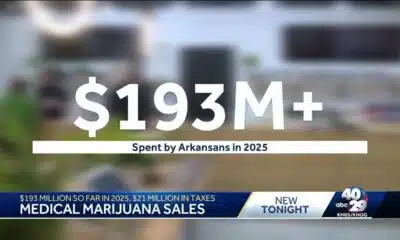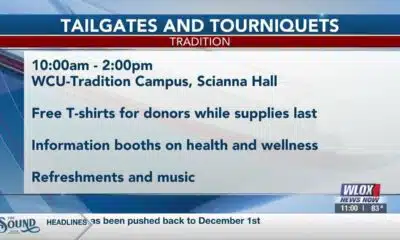Mississippi Today
‘The state threw them to the wolves’: Health department struggles to manage massive medical marijuana program
‘The state threw them to the wolves’: Health department struggles to manage massive medical marijuana program
Behind closed doors, Mississippi’s eight-person medical cannabis office is struggling against its workload.
The Health Department office charged by the Legislature with running Mississippi’s new medical marijuana program is steeped in disorganization: agents rarely visit cultivation sites, application backlogs reach hundreds deep, and lags in communication with licensees often stretch on for weeks, a Mississippi Today investigation found.
Business owners feel frustrated, unheard and worried that the millions of dollars they invested — and the tens of thousands they paid in fees to the state — could go up in smoke.
“The state threw them to the wolves,” cultivator Joel Harper said of the fledgling marijuana office. “They should have paid the money to bring in professionals, even a third-party consultant. Instead, they’re sending people out into the cannabis world who have no idea about anything cannabis.”
At the center is a handful of workers, tasked with unrolling a massive program without enough staffing to operate efficiently. Cultivators say when they do hear back from the office, the messages are incomplete or inconsistent – especially when it comes to how they construct their farming facilities.
And that’s if they hear back at all. The office already has mountains of unprocessed paperwork.
As of the second week of January, 277 work permit applications sat in a queue waiting to be processed, according to copies of the office’s records obtained by Mississippi Today. Could-be cannabis workers can’t start their jobs without permits. Another 995 patients had yet to to be told whether or not they’ve been approved for their dispensary cards.
Three dozen businesses had their own applications stuck, along with almost 40 other medical practitioners, the records show.
In a statement to Mississippi Today, department of health spokesperson Liz Sharlot acknowledged the backlogs.
“We are working with the MMCP (Mississippi Medical Cannabis Program) Licensing Director and the team on how to put more efficient processes in place,” she said.
Even when the office hired new workers – growing from four to eight in recent months – little was done to train them on the law and the industry, an employee of the health department told Mississippi Today. The employee spoke on the condition of anonymity out of fear of repercussions.
The health department said in October, when Mississippi Today first reported the backlogs, it was working to fill 25 more positions. That has yet to happen.
The health department worker said much of the disorganization stems from the office’s former director Kris Jones Adcock.
The Department of Health did not answer questions related to plans to increase staffing levels or what medical marijuana-related training their current staffers received.
“The people of Mississippi deserve better,” the worker said.

During one five-week period, Adcock held three jobs simultaneously within the health department: the cannabis role, the head of a domestic violence office, and a promotion to a department-wide role as assistant senior deputy.
The health department didn’t respond to questions about the effects managing three positions may have had on her ability to run the cannabis office. Adcock now holds only one department-wide role: Assistant Senior Deputy to the Senior Deputy.
Adcock announced two weeks ago that the office’s attorney, Laura Goodson, would be the acting director.
The health department employee also said Adcock set a tone of rushed processes and absentee leadership that has left the marijuana office in clean-up mode.
“There was no due diligence on some of the applications,” the worker said. “Some of it was her knee-jerk reaction to get stuff out the door after it (the backlog) built up. Instead of an orderly process, it was just rushed.”
Emails obtained by Mississippi Today show that it wasn’t just cultivators struggling to hear back. The head of a lab testing facility also expressed frustration.
“The complete lack of communication is just not feasible any longer,” Rapid Analytics director Jeff Keller wrote to Adcock on Dec. 16. “I am begging you to please just name the time on Monday and I will make it work.”
A month later, one of Keller’s employees sent his own desperate plea to the office.
“I’m trying to find out when I’ll be able to start working there,” he wrote about his job at the lab. “My background check was cleared on December 15th … I’ve left multiple messages but have not received a response.”
The CEO of test facility Steep Hill, Cliff Osbon, sent his own email on Jan. 13 on behalf of four employees who still needed their work permits so they could begin work and the lab could start testing marijuana.
Neither testing lab responded to Mississippi Today’s request for a comment.
Zack Wilson, a micro-grower in Potts Camp, said he had a worker waiting more than two weeks on a work permit.
“You send an email. Wait two weeks. Email again,” Wilson said. “You just sit and wait. I know they’re short staffed, but come on guys.”

Cultivators say unanswered questions have led to a murky-at-best understanding of how some of the regulations are being interpreted and enforced.
That’s bubbled up with the use of so-called “adapted greenhouses,” putting already competitive cultivators more at odds. The regulations call for no outdoor growing, a solid roof, permanent walls and slab foundations.
In the early days after the law was passed, Harper, the head of Como-based Pharm Grown Canna Company, said officials made it clear to industry hopefuls that greenhouses would not be approved as growing facilities. So he, like many others, invested money in renovating a large warehouse that would rely on artificial lights.
In the last few months, he’s noticed much cheaper greenhouse-style structures popping up with the health department’s approval.
Harper and others who followed the bill’s creation closely say greenhouses go against the spirit of what legislators intended.
The debate comes down to word definitions that aren’t spelled out in the law itself. If the bill doesn’t allow any “outdoor” growing, that should mean the structure can’t utilize the sun, some argue. The greenhouses have clear-plastic roofs to use a mix of sun and artificial light. If the facility needs to have a solid and secure roof, clear plastic shouldn’t be permitted, according to some interpretations.
Cultivators like Wilson don’t see it that way.
“The roof certainly isn’t made of liquid or gas,” he said. “Plastic is a solid.”
Wilson said his site plan, including the materials he was using, were all approved by the health department when he handed in his application. He was given his cultivation license in August, according to public records.
Another cultivator, Jason McDonald, is building his own greenhouse under the company name SADUJA. He received his license on Dec. 22. He said his roof is two layers of clear plastic. He has screened-in shutter windows, a cement foundation and plumbing. McDonald runs a tea farm. He’s used to meeting regulations and dealing with bureaucracy and hopes to start growing marijuana by the end of the month.
Mississippi Today also obtained documents Adcock signed off on the site plan, including a hand-drawing where the facility was labeled “greenhouse.”
“I emailed them and asked: ‘Will this greenhouse we’re planning to build meet regs?” McDonald recalled. “They came back and said: ‘you need to read the regulations’ so, I quoted the regulations and said ‘what’s the ruling on this?’ and they said ‘you need to read the regulations.’ I added the specific subsection, and then never got an answer back.”
The word greenhouse, he said, can summon something different depending on the cultivator. He, like others, agrees Mockingbird Cannabis should have been cited for its greenhouse that was under scrutiny in the fall because it had roll-up sides, not permanent walls.
Mockingbird also built a massive state-of-the-art warehouse as its main cultivation site.
“I will tell you we haven’t done anything we didn’t disclose to the Department of Health and in our application,” Mockingbird CEO Clint Patterson told Mississippi Today in October.
Harper and other warehouse operators don’t blame the small businesses for building greenhouses — they’re cheaper to construct and run, leading to significantly higher profit margins. They blame the state for approving them.
“We want them to succeed,” Harper said of greenhouse growers. “We just want them to do it in the way everybody else had to.”
The leading authors behind the bill that created the medical marijuana program could not be reached by Mississippi Today after repeated requests for comment. Rep. Lee Yancey said in the fall that it was the health department’s job to interpret the rules, and if the statutes were not clear enough, it would be addressed in the Legislature.
Sharlot, the health department spokesperson, said it did not approve a model for greenhouses and pointed to the “regulations that specify the physical requirements for a cultivation facility.”
“The MSDH met and continues to meet its statutory requirements as it did with the aggressive timelines in creating the MMCP,” she said.

On Jan. 11, Adcock brought her recommended changes to cannabis regulations before the board of health hoping for the members’ swift approval.
Public commenting regarding updates to the regulations were open for less than a week, ending the day before Christmas Eve. It got about 150 comments, Adcock told the board.
The end result was a thick stack of paper delivered to each board member fewer than two days before the meeting.
“To get 1,000 pages, less than 48 hours before our meeting, it’s almost impossible to review to know what we’re really doing,” said Jim Perry, the head of the board’s cannabis committee.
Adcock’s proposed changes covered everything from batch sizes for testing to whether a cultivation license could cover more than one growing space under a single license.
During the meeting, Perry said he wasn’t comfortable with passing changes without time to review them and ask questions. State Health Officer Dr. Daniel Edney apologized to the board for the ream of paper and the lack of notice. He promised it wouldn’t happen again.
“Cannabis is special and unique and needs to be heavily vetted,” Edney said at the meeting.
Adcock went over some of the regulation changes she said were the most “emergent,” but ultimately the board chose not to act.
Following the meeting, Perry told a Mississippi Today reporter the committee process was created so “we can hear from people and be able to make well-informed and not rushed decisions.”
A committee meeting about the regulations has been scheduled for Jan. 26 at 3 p.m.

With the constant flood of applicants, strapped-for-time staffers aren’t making regular site visits, according to cultivators and those with inside knowledge of the office. That means growers can get their provisional four-month licenses extended, begin growing, finish batches and have them tested and sent to market without having ever met an agent in person.
Onsite visits are required for a renewal of a license, but not for moving a provisional license to a permanent one, according to the health department. When asked about the frequency of agent visits, Sharlot emphasized that the office is remotely monitoring all cultivators with the seed-to-sale tracking program.
Meanwhile, the 163 licensed dispensaries are eying the number of patients – Sharlot said 1,732 as of Monday – who have licenses to purchase medical cannabis. They’re worried it won’t be enough to sustain a business after months paying rent without revenue.
The department of health worker who spoke to Mississippi Today said whenever they make a dent in the patient queue, it doesn’t take long to climb back over 1,000.
The health department says it has licensed a total of 73 cultivators; 12 processors; four waste disposal companies; nine transportation companies; three testing labs; 151 medical practitioners; and 975 workers with permits.
It’s a constant battle to keep up.
This article first appeared on Mississippi Today and is republished here under a Creative Commons license.
Mississippi Today
Mississippi prepares for another execution
The Mississippi Supreme Court has set the execution of a man who kidnapped and murdered a 20-year-old community college student in north Mississippi 30 years ago.
Charles Ray Crawford, 59, is set to be executed Oct. 15 at the Mississippi State Penitentiary at Parchman, after multiple requests by the attorney general’s office.
Eight justices joined the majority opinion to set the execution, concluding that Crawford has exhausted all state and federal legal remedies. Mississippi Supreme Court Justice T. Kenneth Griffis Jr. wrote the Friday opinion. Justice David Sullivan did not participate.
However, Kristy Noble with the Mississippi Office of Capital Post-Conviction Counsel released a statement saying it will file another appeal with the U.S. Supreme Court.
“”Mr. Crawford’s inexperienced trial counsel conceded his guilt to the jury — against Mr.
Crawford’s timely and repeated objections,” Noble said in the statement. “Mr. Crawford told his counsel to pursue a not guilty verdict. Counsel did just the opposite, which is precisely what the U.S. Supreme Court says counsel cannot do,” Noble said in the statement.
“A trial like Mr. Crawford’s – one where counsel concedes guilt over his client’s express wishes – is essentially no trial at all.”
Last fall, Crawford’s attorneys asked the court not to set an execution date because he hadn’t exhausted appeal efforts in federal court to challenge a rape conviction that is not tied to his death sentence. In June, the U.S. Supreme Court declined to take up Crawford’s case.
A similar delay occurred a decade ago, when the AG’s office asked the court to reset Crawford’s execution date, but that was denied because efforts to appeal his unrelated rape conviction were still pending.
After each unsuccessful filing, the attorney general’s office asked the Mississippi Supreme Court to set Crawford’s execution date.
On Friday, the court also denied Crawford’s third petition for post-conviction relief and a request for oral argument. It accepted the state’s motion to dismiss the petition. Seven justices concurred and Justice Leslie King concurred in result only. Again, Justice Sullivan did not participate.
Crawford was convicted and sentenced to death in Lafayette County for the 1993 rape and murder of North Mississippi Community College student Kristy Ray.
Days before he was set to go to trial on separate aggravated assault and rape charges, he kidnapped Ray from her parents’ Tippah County home, leaving ransom notes. Crawford took Ray to an abandoned barn where he stabbed her, and his DNA was found on her, indicating he sexually assaulted her, according to court records.
Crawford told police he had blackouts and only remembered parts of the crime, but not killing Ray. Later he admitted “he must of killed her” and led police to Ray’s body, according to court records.
At his 1994 trial he presented an insanity defense, including that he suffered from psychogenic amnesia – periods of time lapse without memory. Medical experts who provided rebuttal testimony said Crawford didn’t have psychogenic amnesia and didn’t show evidence of bipolar illness.
The last person executed in Mississippi was Richard Jordan in June, previously the state’s oldest and longest serving person on death row.
There are 36 people on death row, according to records from the Mississippi Department of Corrections.
Update 9/15/25: This story has been updated to include a response from the Mississippi Office of Capital Post-Conviction Counsel
This article first appeared on Mississippi Today and is republished here under a Creative Commons Attribution-NoDerivatives 4.0 International License.
The post Mississippi prepares for another execution appeared first on mississippitoday.org
Note: The following A.I. based commentary is not part of the original article, reproduced above, but is offered in the hopes that it will promote greater media literacy and critical thinking, by making any potential bias more visible to the reader –Staff Editor.
Political Bias Rating: Centrist
The article presents a factual and balanced account of the legal proceedings surrounding a scheduled execution in Mississippi. It includes perspectives from both the state’s attorney general’s office and the defense counsel, without using emotionally charged language or advocating for a particular political stance. The focus on legal details and court decisions reflects a neutral, informative approach typical of centrist reporting.
Mississippi Today
Presidents are taking longer to declare major natural disasters. For some, the wait is agonizing
TYLERTOWN — As an ominous storm approached Buddy Anthony’s one-story brick home, he took shelter in his new Ford F-250 pickup parked under a nearby carport.
Seconds later, a tornado tore apart Anthony’s home and damaged the truck while lifting it partly in the air. Anthony emerged unhurt. But he had to replace his vehicle with a used truck that became his home while waiting for President Donald Trump to issue a major disaster declaration so that federal money would be freed for individuals reeling from loss. That took weeks.
“You wake up in the truck and look out the windshield and see nothing. That’s hard. That’s hard to swallow,” Anthony said.
Disaster survivors are having to wait longer to get aid from the federal government, according to a new Associated Press analysis of decades of data. On average, it took less than two weeks for a governor’s request for a presidential disaster declaration to be granted in the 1990s and early 2000s. That rose to about three weeks during the past decade under presidents from both major parties. It’s taking more than a month, on average, during Trump’s current term, the AP found.
The delays mean individuals must wait to receive federal aid for daily living expenses, temporary lodging and home repairs. Delays in disaster declarations also can hamper recovery efforts by local officials uncertain whether they will receive federal reimbursement for cleaning up debris and rebuilding infrastructure. The AP collaborated with Mississippi Today and Mississippi Free Press on the effects of these delays for this report.
“The message that I get in the delay, particularly for the individual assistance, is that the federal government has turned its back on its own people,” said Bob Griffin, dean of the College of Emergency Preparedness, Homeland Security and Cybersecurity at the University at Albany in New York. “It’s a fundamental shift in the position of this country.”
The wait for disaster aid has grown as Trump remakes government
The Federal Emergency Management Agency often consults immediately with communities to coordinate their initial disaster response. But direct payments to individuals, nonprofits and local governments must wait for a major disaster declaration from the president, who first must receive a request from a state, territory or tribe. Major disaster declarations are intended only for the most damaging events that are beyond the resources of states and local governments.
Trump has approved more than two dozen major disaster declarations since taking office in January, with an average wait of almost 34 days after a request. That ranged from a one-day turnaround after July’s deadly flash flooding in Texas to a 67-day wait after a request for aid because of a Michigan ice storm. The average wait is up from a 24-day delay during his first term and is nearly four times as long as the average for former Republican President George H.W. Bush, whose term from 1989-1993 coincided with the implementation of a new federal law setting parameters for disaster determinations.
The delays have grown over time, regardless of the party in power. Former Democratic President Joe Biden, in his last year in office, averaged 26 days to declare major disasters — longer than any year under former Democratic President Barack Obama.

FEMA did not respond to the AP’s questions about what factors are contributing to the trend.
Others familiar with FEMA noted that its process for assessing and documenting natural disasters has become more complex over time. Disasters have also become more frequent and intense because of climate change, which is mostly caused by the burning of fuels such as gas, coal and oil.
The wait for disaster declarations has spiked as Trump’s administration undertakes an ambitious makeover of the federal government that has shed thousands of workers and reexamined the role of FEMA. A recently published letter from current and former FEMA employees warned the cuts could become debilitating if faced with a large-enough disaster. The letter also lamented that the Trump administration has stopped maintaining or removed long-term planning tools focused on extreme weather and disasters.
Shortly after taking office, Trump floated the idea of “getting rid” of FEMA, asserting: “It’s very bureaucratic, and it’s very slow.”
FEMA’s acting chief suggested more recently that states should shoulder more responsibility for disaster recovery, though FEMA thus far has continued to cover three-fourths of the costs of public assistance to local governments, as required under federal law. FEMA pays the full cost of its individual assistance.
Former FEMA Administrator Pete Gaynor, who served during Trump’s first term, said the delay in issuing major disaster declarations likely is related to a renewed focus on making sure the federal government isn’t paying for things state and local governments could handle.
“I think they’re probably giving those requests more scrutiny,” Gaynor said. “And I think it’s probably the right thing to do, because I think the (disaster) declaration process has become the ‘easy button’ for states.”
The Associated Press on Monday received a statement from White House spokeswoman Abigail Jackson in response to a question about why it is taking longer to issue major natural disaster declarations:
“President Trump provides a more thorough review of disaster declaration requests than any Administration has before him. Gone are the days of rubber stamping FEMA recommendations – that’s not a bug, that’s a feature. Under prior Administrations, FEMA’s outsized role created a bloated bureaucracy that disincentivized state investment in their own resilience. President Trump is committed to right-sizing the Federal government while empowering state and local governments by enabling them to better understand, plan for, and ultimately address the needs of their citizens. The Trump Administration has expeditiously provided assistance to disasters while ensuring taxpayer dollars are spent wisely to supplement state actions, not replace them.”

In Mississippi, frustration festered during wait for aid
The tornado that struck Anthony’s home in rural Tylertown on March 15 packed winds up to 140 mph. It was part of a powerful system that wrecked homes, businesses and lives across multiple states.
Mississippi’s governor requested a federal disaster declaration on April 1. Trump granted that request 50 days later, on May 21, while approving aid for both individuals and public entities.
On that same day, Trump also approved eight other major disaster declarations for storms, floods or fires in seven other states. In most cases, more than a month had passed since the request and about two months since the date of those disasters.
If a presidential declaration and federal money had come sooner, Anthony said he wouldn’t have needed to spend weeks sleeping in a truck before he could afford to rent the trailer where he is now living. His house was uninsured, Anthony said, and FEMA eventually gave him $30,000.
In nearby Jayess in Lawrence County, Dana Grimes had insurance but not enough to cover the full value of her damaged home. After the eventual federal declaration, Grimes said FEMA provided about $750 for emergency expenses, but she is now waiting for the agency to determine whether she can receive more.

“We couldn’t figure out why the president took so long to help people in this country,” Grimes said. “I just want to tie up strings and move on. But FEMA — I’m still fooling with FEMA.”
Jonathan Young said he gave up on applying for FEMA aid after the Tylertown tornado killed his 7-year-old son and destroyed their home. The process seemed too difficult, and federal officials wanted paperwork he didn’t have, Young said. He made ends meet by working for those cleaning up from the storm.
“It’s a therapy for me,” Young said, “to pick up the debris that took my son away from me.”
Historically, presidential disaster declarations containing individual assistance have been approved more quickly than those providing assistance only to public entities, according to the AP’s analysis. That remains the case under Trump, though declarations for both types are taking longer.
About half the major disaster declarations approved by Trump this year have included individual assistance.
Some people whose homes are damaged turn to shelters hosted by churches or local nonprofit organizations in the initial chaotic days after a disaster. Others stay with friends or family or go to a hotel, if they can afford it.
But some insist on staying in damaged homes, even if they are unsafe, said Chris Smith, who administered FEMA’s individual assistance division under three presidents from 2015-2022. If homes aren’t repaired properly, mold can grow, compounding the recovery challenges.

That’s why it’s critical for FEMA’s individual assistance to get approved quickly — ideally, within two weeks of a disaster, said Smith, who’s now a disaster consultant for governments and companies.
“You want to keep the people where they are living. You want to ensure those communities are going to continue to be viable and recover,” Smith said. “And the earlier that individual assistance can be delivered … the earlier recovery can start.”
In the periods waiting for declarations, the pressure falls on local officials and volunteers to care for victims and distribute supplies.
In Walthall County, where Tylertown is, insurance agent Les Lampton remembered watching the weather news as the first tornado missed his house by just an eighth of a mile. Lampton, who moonlights as a volunteer firefighter, navigated the collapsed trees in his yard and jumped into action. About 45 minutes later, the second tornado hit just a mile away.
“It was just chaos from there on out,” Lampton said.
Walthall County, with a population of about 14,000, hasn’t had a working tornado siren in about 30 years, Lampton said. He added there isn’t a public safe room in the area, although a lot of residents have ones in their home.
Rural areas with limited resources are hit hard by delays in receiving funds through FEMA’s public assistance program, which, unlike individual assistance, only reimburses local entities after their bills are paid. Long waits can stoke uncertainty and lead cost-conscious local officials to pause or scale-back their recovery efforts.

In Walthall County, officials initially spent about $700,000 cleaning up debris, then suspended the cleanup for more than a month because they couldn’t afford to spend more without assurance they would receive federal reimbursement, said county emergency manager Royce McKee. Meanwhile, rubble from splintered trees and shattered homes remained piled along the roadside, creating unsafe obstacles for motorists and habitat for snakes and rodents.
When it received the federal declaration, Walthall County took out a multimillion-dollar loan to pay contractors to resume the cleanup.
“We’re going to pay interest and pay that money back until FEMA pays us,” said Byran Martin, an elected county supervisor. “We’re hopeful that we’ll get some money by the first of the year, but people are telling us that it could be [longer].”
Lampton, who took after his father when he joined the volunteer firefighters 40 years ago, lauded the support of outside groups such as Cajun Navy, Eight Days of Hope, Samaritan’s Purse and others. That’s not to mention the neighbors who brought their own skid steers and power saws to help clear trees and other debris, he added.
“That’s the only thing that got us through this storm, neighbors helping neighbors,” Lampton said. “If we waited on the government, we were going to be in bad shape.”
Lieb reported from Jefferson City, Missouri, and Wildeman from Hartford, Connecticut.
Update 98/25: This story has been updated to include a White House statement released after publication.
This article first appeared on Mississippi Today and is republished here under a Creative Commons Attribution-NoDerivatives 4.0 International License.
The post Presidents are taking longer to declare major natural disasters. For some, the wait is agonizing appeared first on mississippitoday.org
Note: The following A.I. based commentary is not part of the original article, reproduced above, but is offered in the hopes that it will promote greater media literacy and critical thinking, by making any potential bias more visible to the reader –Staff Editor.
Political Bias Rating: Center-Left
This article presents a critical view of the Trump administration’s handling of disaster declarations, highlighting delays and their negative impacts on affected individuals and communities. It emphasizes concerns about government downsizing and reduced federal support, themes often associated with center-left perspectives that favor robust government intervention and social safety nets. However, it also includes statements from Trump administration officials defending their approach, providing some balance. Overall, the tone and framing lean slightly left of center without being overtly partisan.
Mississippi Today
Northeast Mississippi speaker and worm farmer played key role in Coast recovery after Hurricane Katrina
The 20th anniversary of Hurricane Katrina slamming the Mississippi Gulf Coast has come and gone, rightfully garnering considerable media attention.
But still undercovered in the 20th anniversary saga of the storm that made landfall on Aug. 29, 2005, and caused unprecedented destruction is the role that a worm farmer from northeast Mississippi played in helping to revitalize the Coast.
House Speaker Billy McCoy, who died in 2019, was a worm farmer from the Prentiss, not Alcorn County, side of Rienzi — about as far away from the Gulf Coast as one could be in Mississippi.
McCoy grew other crops, but a staple of his operations was worm farming.
Early after the storm, the House speaker made a point of touring the Coast and visiting as many of the House members who lived on the Coast as he could to check on them.
But it was his action in the forum he loved the most — the Mississippi House — that is credited with being key to the Coast’s recovery.
Gov. Haley Barbour had called a special session about a month after the storm to take up multiple issues related to Katrina and the Gulf Coast’s survival and revitalization. The issue that received the most attention was Barbour’s proposal to remove the requirement that the casinos on the Coast be floating in the Mississippi Sound.
Katrina wreaked havoc on the floating casinos, and many operators said they would not rebuild if their casinos had to be in the Gulf waters. That was a crucial issue since the casinos were a major economic engine on the Coast, employing an estimated 30,000 in direct and indirect jobs.
It is difficult to fathom now the controversy surrounding Barbour’s proposal to allow the casinos to locate on land next to the water. Mississippi’s casino industry that was birthed with the early 1990s legislation was still new and controversial.
Various religious groups and others had continued to fight and oppose the casino industry and had made opposition to the expansion of gambling a priority.
Opposition to casinos and expansion of casinos was believed to be especially strong in rural areas, like those found in McCoy’s beloved northeast Mississippi. It was many of those rural areas that were the homes to rural white Democrats — now all but extinct in the Legislature but at the time still a force in the House.
So, voting in favor of casino expansion had the potential of being costly for what was McCoy’s base of power: the rural white Democrats.
Couple that with the fact that the Democratic-controlled House had been at odds with the Republican Barbour on multiple issues ranging from education funding to health care since Barbour was inaugurated in January 2004.
Barbour set records for the number of special sessions called by the governor. Those special sessions often were called to try to force the Democratic-controlled House to pass legislation it killed during the regular session.
The September 2005 special session was Barbour’s fifth of the year. For context, current Gov. Tate Reeves has called four in his nearly six years as governor.
There was little reason to expect McCoy to do Barbour’s bidding and lead the effort in the Legislature to pass his most controversial proposal: expanding casino gambling.
But when Barbour ally Lt. Gov. Amy Tuck, who presided over the Senate, refused to take up the controversial bill, Barbour was forced to turn to McCoy.
The former governor wrote about the circumstances in an essay he penned on the 20th anniversary of Hurricane Katrina for Mississippi Today Ideas.
“The Senate leadership, all Republicans, did not want to go first in passing the onshore casino law,” Barbour wrote. “So, I had to ask Speaker McCoy to allow it to come to the House floor and pass. He realized he should put the Coast and the state’s interests first. He did so, and the bill passed 61-53, with McCoy voting no.
“I will always admire Speaker McCoy, often my nemesis, for his integrity in putting the state first.”
Incidentally, former Rep. Bill Miles of Fulton, also in northeast Mississippi, was tasked by McCoy with counting, not whipping votes, to see if there was enough support in the House to pass the proposal. Not soon before the key vote, Miles said years later, he went to McCoy and told him there were more than enough votes to pass the legislation so he was voting no and broached the idea of the speaker also voting no.
It is likely that McCoy would have voted for the bill if his vote was needed.
Despite his no vote, the Biloxi Sun Herald newspaper ran a large photo of McCoy and hailed the Rienzi worm farmer as a hero for the Mississippi Gulf Coast.
This article first appeared on Mississippi Today and is republished here under a Creative Commons Attribution-NoDerivatives 4.0 International License.
The post Northeast Mississippi speaker and worm farmer played key role in Coast recovery after Hurricane Katrina appeared first on mississippitoday.org
Note: The following A.I. based commentary is not part of the original article, reproduced above, but is offered in the hopes that it will promote greater media literacy and critical thinking, by making any potential bias more visible to the reader –Staff Editor.
Political Bias Rating: Centrist
The article presents a factual and balanced account of the political dynamics surrounding Hurricane Katrina recovery efforts in Mississippi, focusing on bipartisan cooperation between Democratic and Republican leaders. It highlights the complexities of legislative decisions without overtly favoring one party or ideology, reflecting a neutral and informative tone typical of centrist reporting.
-
News from the South - Arkansas News Feed7 days ago
Group in lawsuit say Franklin county prison land was bought before it was inspected
-
News from the South - Kentucky News Feed6 days ago
Lexington man accused of carjacking, firing gun during police chase faces federal firearm charge
-
The Center Square6 days ago
California mother says daughter killed herself after being transitioned by school | California
-
News from the South - Arkansas News Feed6 days ago
Arkansas medical marijuana sales on pace for record year
-
Local News Video6 days ago
William Carey University holds 'tailgates and tourniquets' blood drive
-
News from the South - Alabama News Feed6 days ago
Zaxby's Player of the Week: Dylan Jackson, Vigor WR
-
News from the South - Missouri News Feed6 days ago
Local, statewide officials react to Charlie Kirk death after shooting in Utah
-
Local News6 days ago
US stocks inch to more records as inflation slows and Oracle soars












































